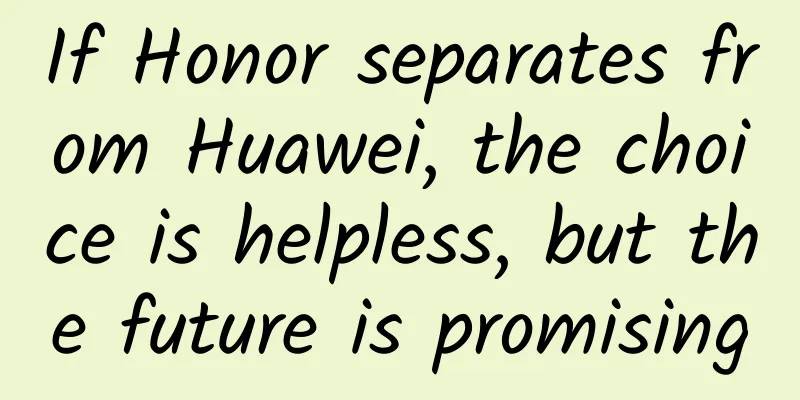If Honor separates from Huawei, the choice is helpless, but the future is promising

|
On October 14, Reuters reported that Huawei is negotiating with bidders such as Digital China to sell its Honor smartphone division, and the transaction value may be as high as 25 billion yuan. Over the past month, news that Honor will be separated from Huawei has repeatedly made headlines in the technology industry. As the "party involved", Honor has unsurprisingly repeatedly stated that "the news is untrue." However, just like many rumors that eventually came true, the technology circle rarely relies on rumors. The more rumors and denials about Honor's independence from Huawei spread, the more it seems to indicate that there are internal motives behind this. In fact, when we consider the situation faced by Honor from an industry perspective, we may find that for Huawei and Honor at present, independence is actually the best choice for the two brands. Glory will leave sooner or later Honor's independence at this point in time in 2020 is somewhat related to some policy restrictions Huawei has suffered, but judging from Honor's development history and goals, "independence" has actually long become a phased goal of Honor's development. As early as September 2018, an insider of Honor leaked that Honor was planning to separate from Huawei and go public in the Hong Kong capital market. The source even revealed that "it has reached the stage of preparing for the official announcement." Considering that Honor has become the fifth largest smartphone brand in China, once it goes public, it will surely be sought after by the capital market and seek a broader development space. Unfortunately, perhaps because of the game at the company level or for the needs of the IoT era, Honor did not take a practical step in 2018. Man proposes, God disposes. What Honor did not expect was that since 2019, the United States began to unilaterally impose policy bans on Huawei, which directly affected the supply of core components of Huawei's terminal products. Yu Chengdong previously stated that "Kirin 1020 may be Huawei's last self-developed high-end chip." Although Kirin 1020 still has half a year of supply, Huawei will inevitably give priority to its high-end, high-premium Mate series products. Therefore, a major challenge facing Honor in the second half of 2020 is the fatal impact of policies on core terminals. Tianfeng Securities analyst Ming-Chi Kuo said the night before that in response to this dilemma, Honor is likely to separate from Huawei in order to circumvent US sanctions in exchange for growth in mobile phones and other terminals. On the other hand, GFK data shows that in 2019, when the scale of China's smartphone market declined by nearly 10%, Honor's market share in China reached 13%, making it the fourth-ranked and second-fastest-growing mobile phone brand. This also shows that Honor is actually much better than most mobile phone manufacturers in terms of product operation and brand management. Therefore, after becoming independent, when the product is no longer constrained at the supply chain level, Honor mobile phones are likely to maintain a high growth rate. In addition to achieving the above two results in the short term, Honor's independence also has extremely imaginative growth space in the long term. Honor was born out of Huawei. In fact, it is very passive in brand management. For example, President Zhao Ming always emphasizes "Honor has always been committed to creating technology trend products that young people love" at every press conference. The implication is that "middle-aged high-end user group" is an untouchable red line, which is the territory of Huawei's brand. Once separated from Huawei, Honor will most likely further strengthen its brand positioning, unscrupulously improve its product line, and find new incremental space. Secondly, at a time when the smartphone dividend in China is fading, Xiaomi, OPPO, and vivo have already started their overseas expansion journey. However, due to certain reasons, the performance of Huawei's mobile phones in overseas markets in recent years has not been ideal. Currently, Xiaomi's overseas market revenue accounts for 50%. As Xiaomi's "arch-enemy", Honor could only watch Xiaomi swallow up the overseas market. However, once Honor becomes independent, it will not only be able to continue to target Xiaomi, but also expand into the global market more quickly and smoothly. Considering the factors at these two levels, whether from the perspective of long-term development or the short-term difficulties faced by Huawei, the independence of Honor, although somewhat helpless, is the best choice between the two brands. Difficulties are visible to the naked eye Although we can say that Honor's independence has its promising side, the close connection between Honor and Huawei and the current situation faced by Huawei determine that the constraints of Honor's independence exist not only at the capital level, but also in product layout, brand planning and supply chain integration, which are not achieved overnight. Since 2019, with the gradual maturity of 5G and IoT technologies, the Internet of Everything has become a new trend in the technology industry. In the second half of 2019, Honor also closely followed Huawei's "1+8+N full-scenario" strategy and launched smart screen products for home interconnection scenarios. From the industry's perspective, in the bonus period of the Internet of Everything, due to the privacy of device connections, most players are currently focusing on "staking out territory" and grabbing market share. If Honor becomes independent, Honor's mobile phones and Honor Smart Screens and other products will still have a strong correlation, but because Honor's Internet of Everything devices were previously part of Huawei's "1+8+N full-scenario" strategy, the separation itself will greatly affect the competitiveness of Honor terminals. Interestingly, at the end of 2018, the rumors of Honor's independence coincided with the eve of the explosion of the IoT market. In the end, Honor chose to continue to stay under Huawei's wing, perhaps based on this consideration. Although Honor is under the roof of Huawei, all its actions have to depend on the big brother's mood, but in return, Huawei will also give Honor sufficient support at the supply chain level. Take the most important chip of smartphones as an example. Since Huawei produces and sells its own Kirin chips, the Kirin 980 chip equipped in Honor V20 costs only 30 US dollars. In contrast, the Snapdragon 855 chip equipped in Xiaomi 9 costs an astonishing 149 US dollars. Considering that Honor V20 and Xiaomi 9 are both priced at 3,000 yuan, the lower-cost Honor V20 can undoubtedly obtain a higher profit margin than Xiaomi 9. If Honor becomes independent, it will probably find it difficult to obtain further "technical support" from Huawei. The inevitable choice is to become an "assembly plant" similar to Xiaomi. In addition, Honor has always been benchmarking against Xiaomi, and the negative impact brought about by this is that Honor's profit margin will enter a long-term downward channel. Overall, at the end of 2020, Honor is rumored to be independent. In fact, this has certain positive significance for both Huawei and Honor - on the one hand, it can help Huawei reduce its burden, and on the other hand, it can allow Honor to maintain its position in the industry (it is not impossible to return to Huawei in the future). This is undoubtedly the best response that the two brands can make under the current environment. On the other hand, the suddenness of policy restrictions means that Honor's independence may be a hasty and irreversible strategic deployment. What if the environment changes again? Then, the previously highly inertial business will not only find it difficult to adapt to the sudden deviation, but may even put the Honor brand in a dangerous situation of restarting. Perhaps, it is this dual possibility that makes Honor and Huawei hesitant, but the question is, how much time chips do they have now? As a winner of Toutiao's Qingyun Plan and Baijiahao's Bai+ Plan, the 2019 Baidu Digital Author of the Year, the Baijiahao's Most Popular Author in the Technology Field, the 2019 Sogou Technology and Culture Author, and the 2021 Baijiahao Quarterly Influential Creator, he has won many awards, including the 2013 Sohu Best Industry Media Person, the 2015 China New Media Entrepreneurship Competition Beijing Third Place, the 2015 Guangmang Experience Award, the 2015 China New Media Entrepreneurship Competition Finals Third Place, and the 2018 Baidu Dynamic Annual Powerful Celebrity. |
Recommend
Xue Wei's Psychology Micro-Course 101 Episodes: The Devil is One Foot High, the Way is Ten Feet High - 101 Times to Face Up to Challenges Video Course
Xue Wei's Psychology Micro-Course 101 Episode...
Which ocean satellites has my country independently developed?
my country has always attached great importance t...
Product promotion: 4 ways to attract seed users
The author of this article will introduce some st...
2021 Data Analysis Practice, Getting Started with Data Analysis from 0 Basics
2021 Data Analysis Practice, Getting Started with...
Urgent reminder! Don’t do these 10 things in summer, otherwise you will be sick
This article was reviewed by Pa Li Ze, chief phys...
Gmail for iOS: Handling emails in notifications
After this upgrade, users can finally simply proc...
"The ugliest animal in the world"? No, it's a great miracle of evolution
In the north of my country, there is a unique ter...
Why do you fry two dough sticks together? Is it because of love? "Singles" please avoid...
This article was reviewed by Liu Shaowei, Deputy ...
Product operation: scenario-based operation plan for community group purchasing!
The generally mentioned scenario is directly base...
In the screen age, how to minimize the impact of electronic screens on children?
Source: Ni Xiaojiang & Jing'an CDC...
The universal formula for operating private domain traffic in offline stores!
How to create private domain for offline stores? ...
After studying more than 1,000 cases, it was found that user experience design can be refined into these 12 steps
Hello everyone, this is TCC Translation Intellige...
Flowers of Evil Comics: How to do SEO for your personal website? What are the precautions?
There is no big difference in the methods of doin...
Sad! Only 64 Nanjing Massacre survivors left...
Nanjing Massacre survivor Xu Jiaqing Died at 8:30...









